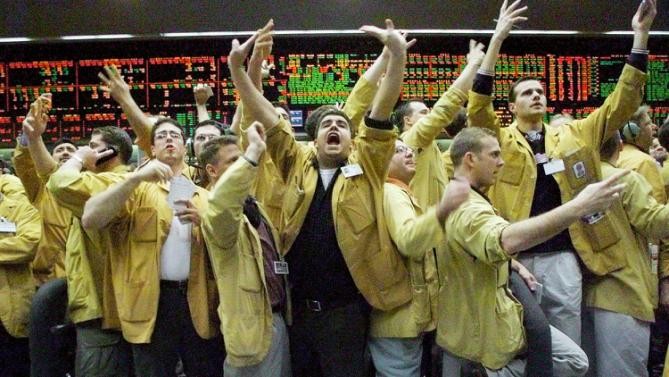Why the CME shutting down floor trading matters
Post on: 19 Июнь, 2015 No Comment

Tim Boyle | Bloomberg | Getty Images
Traders work in trading floor of the CME Group's Chicago Board of Trade in Chicago.
The Chicago futures trading pits will soon be a thing of the past.
The decision by CME Group will end a 167-year era when it goes into effect in July. Despite bringing closure on the Wild West arm of Wall Street, where shouting matches and even physical altercations accompanied fortunes being won and lost, the move to fully electronic trading could have real implications for trading in everything from grain to gold.
CME, the world’s largest futures market, is closing the open outcry pits for futures on its NYMEX property in New York as well. The options pits on both floors, where much of the manpower and activity gravitated, will remain open for now.
The first line in the CME’s announcement Wednesday points out that open outcry had fallen to just 1 percent of the firm’s total futures volume.
But while their volume dried up, the mere presence of traders on the floor still helped keep trading orderly, current and former pit traders said. The transition to completely electronic will open a small window for computer trading wielded by hedge funds and high-frequency trading firms to be used for some questionable activity, they said.
At the very least it could lead to more volatility in futures contracts for later months, where volume is typically thin.
The real issue will be the manipulation of the back-month spread market, said David Greenberg, a former board member at the New York Mercantile Exchange who’s lectured about the positives and negatives of electronic trading to business schools. Without those traders and the floor settlement committee, who really understand the spread market in the metals and energy markets, it opens the door for traders from large companies to settle the market by introducing a large order in the electronic market to paint the tape.
Open outcry trading, depicted in such movies as Trading Places and Ferris Bueller’s Day Off, is simply defined as buying and selling using hand and vocal signals in person. What Greenberg speaks to is how that face-to-face, albeit slower, trading interaction served as a self-policing mechanism.
How far back does this kind of trading go? The predecessor of the CME Group, the Chicago Board of Trade, was formed in 1848 on South Water Street in Chicago, according to CME’s website. The New York Butter, Cheese and Egg Exchange, which would later become the NYMEX, started in New York in 1882.
The beginning of the end appears to be when the CME first went public in 2002. The NYMEX had its IPO in 2006. Many traders feel this is when the formerly member-owned partnerships started to favor profits over orderly markets.
After some pits being open for 167 years, the paramount focus became more volume for more revenue, said one current CME trader, who wanted to remain anonymous because he is still working at the CME.
It’s been a long time coming, said Greenberg, who was a board member when the NYMEX went public. They only kept the NYMEX floor open due to the contract that was signed in the (CME) takeover.
The New York Stock Exchange, which is owned by the Intercontinental Exchange, still has open outcry trading of equities, but every few months executives are asked to deny media reports of a floor closing or sale of the Big Board.
The latest denial came from NYSE President Thomas Farley on Jan. 23, when he told CNBC, We’re very committed to the New York Stock Exchange business. It’s doing great. And we’re very committed to the floor also.
In 2015, open outcry trading’s decent became even more rapid, perhaps forcing the CME’s hand in making Wednesday’s announcement.
For example, just 38,304 gold futures contracts changed hands in person in the Comex pits in January, down 29 percent from the same month a year ago, according to the CME. Meanwhile electronic trading in gold in January was up by more than 20 percent.
Open outcry options trading is holding its own, however. For example, pit trading for 10-year Treasury note options rose 17 percent this January year over year to 3.7 million. That almost kept pace with the 22 percent gain in electronic trading of the same option contracts.
But besides the trading implications, there’s a human side to this story. Many former traders interviewed for this article spoke about how the trading pits were a way for those with blue-collar backgrounds to claw their way into finance alongside their Ivy League pedigreed peers.
The Chicago floors were unique social environments that I treasured, said Donald Luskin, who traded on the Chicago Board of Exchange in the early-1980s and would go on to become a respected and veteran investment officer with Wells Fargo and BlackRock. They were ladders of opportunity through which completely noncredentialed new entrants could get up close and personal with high finance.
CME said in its statement about the closing that it will make every attempt to make booth space available to those who want to trade electronically from the floors.
The exchange also said open outcry trading of S&P 500 futures will continue on its Chicago floor. Floor trading in those contracts fell just 3 percent last month, according to the exchange.
Like Luskin, many current and former members lamented the gritty environment of the floor that built not only careers, but life skills.
Everyone there is trying to take advantage of everyone else. It is dog eat dog. Yet the acts of kindness and friendship and generosity that emerge from the combat create a kind of camaraderie I’ve never experienced anywhere else, said Luskin, who is chief investment officer at his own firm, Trend Macrolytics.
The CME is expected to address the shutdown more in depth on its earnings call after the bell Thursday.














